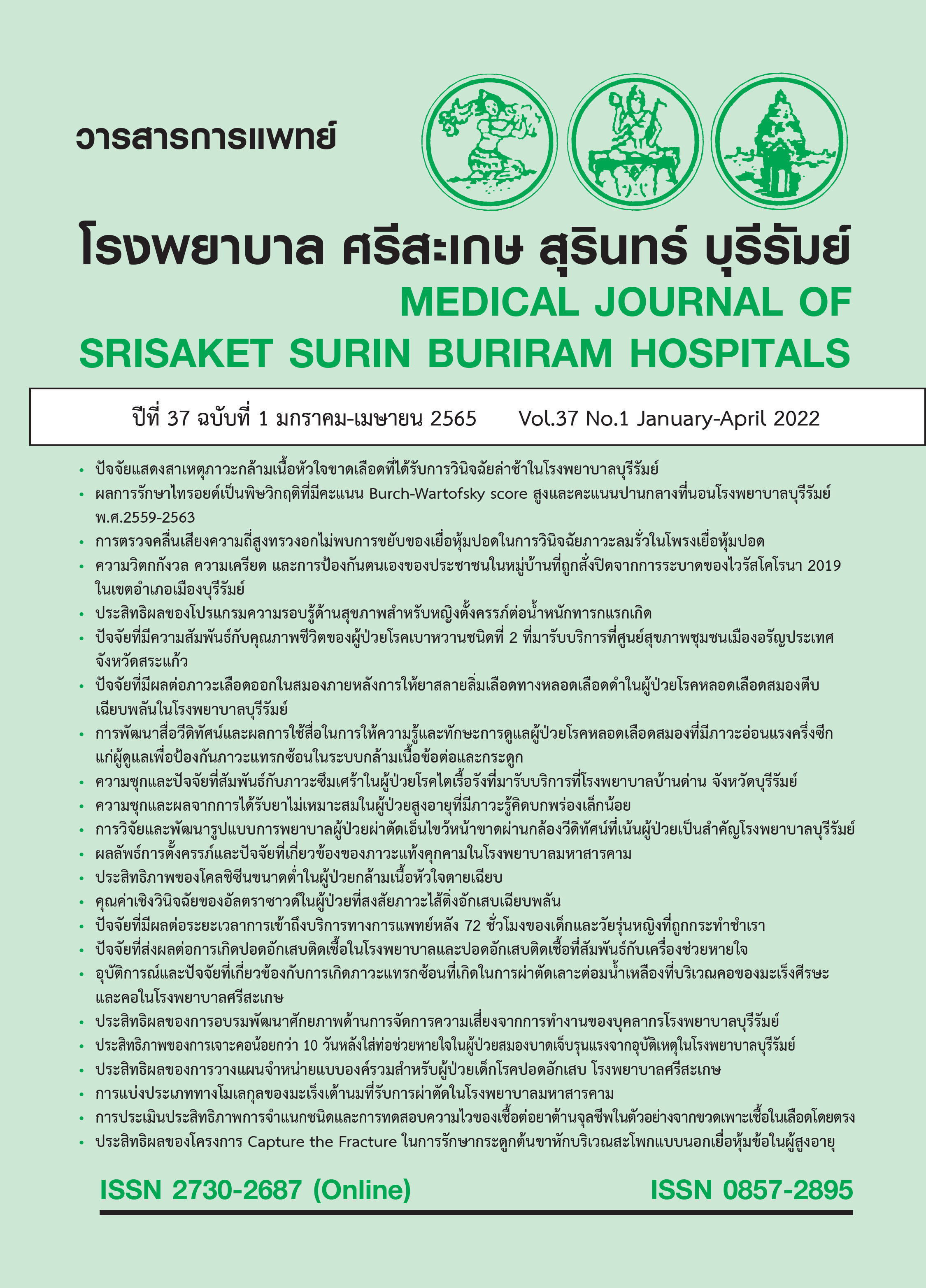การประเมินประสิทธิภาพการจำแนกชนิดและการทดสอบความไวของเชื้อต่อยาต้านจุลชีพในตัวอย่างจากขวดเพาะเชื้อในเลือดโดยตรง
Main Article Content
บทคัดย่อ
หลักการและเหตุผล: โลหิตเป็นพิษเหตุติดเชื้อแบคทีเรีย เป็นสาเหตุสำคัญของการเสียชีวิตในผู้ป่วยที่เข้ารับการรักษาในโรงพยาบาลการวินิจฉัยการติดเชื้อในกระแสเลือดได้รวดเร็ว ถูกต้อง แม่นยำ จึงมีความสำคัญต่อการรักษา รวมทั้งลดอัตราการดื้อยาปฏิชีวนะและการเสียชีวิตของผู้ป่วย
วัตถุประสงค์: เพื่อประเมินประสิทธิภาพการจำแนกชนิดและการทดสอบความไวของเชื้อต่อยาต้านจุลชีพ ในตัวอย่างจากขวดเพาะเชื้อในเลือดโดยตรงด้วยเครื่องอัตโนมัติ เปรียบเทียบกับวิธีมาตรฐาน ในโรงพยาบาลสุรินทร์
วิธีการศึกษา: การศึกษานี้ใช้ตัวอย่างจากผู้ป่วยที่เข้ารับการรักษาในโรงพยาบาลสุรินทร์ ที่มีผลบวกจากการเพาะเชื้อในเลือดจำนวน 98 ตัวอย่าง ทำการจำแนกชนิดเชื้อและทดสอบความไวต่อยาต้านจุลชีพ โดยใช้ตัวอย่างจากขวดเพาะเชื้อโดยตรงเปรียบเทียบกับวิธีมาตรฐานที่ใช้โคโลนีของเชื้อ
ผลการศึกษา: พบว่าการทดสอบการบ่งชี้ชนิดของเชื้อแบคทีเรียโดยการเตรียมตัวอย่างจากจากขวดเพาะเชื้อโดยตรงเมื่อเปรียบเทียบกับการเตรียมตัวอย่างตามวิธีมาตรฐานเป็นเชื้อแบคทีเรียแกรมลบ จำนวน 66 ตัวอย่าง มีค่าความไว และค่าความเชื่อมั่น 95%CI เท่ากับ ร้อยละ 95.5 และร้อยละ 87.3-99.1 ตามลำดับ ขณะที่พบเชื้อแบคทีเรียแกรมบวก จำนวน 32 ตัวอย่าง มีค่าความไว และค่าความเชื่อมั่น 95%CI เท่ากับ ร้อยละ 84.4 และ ร้อยละ 67.2-94.7 ตามลำดับ และเมื่อทำการทดสอบความไวต่อยาต้านจุลชีพมีค่า Essential agreement (EA) และ Categorical agreement (CA) เท่ากับร้อยละ 98 และ 96.5 ตามลำดับ และมีความผิดพลาด ร้อยละ 3.5 สำหรับเชื้อแบคทีเรียแกรมลบเมื่อเทียบกับวิธีมาตรฐาน และมีค่า EA และ CA เท่ากับ ร้อยละ 94 มีอัตราความผิดพลาด ร้อยละ 5.6 สำหรับเชื้อแบคทีเรียแกรมบวกเมื่อเทียบกับวิธีมาตรฐาน ระยะเวลาที่ใช้ในการบ่งชี้ชนิดของเชื้อและทดสอบความไวต่อยาจากขวดเพาะเชื้อในเลือดโดยตรง 10-16 ชั่วโมง และจากวิธีมาตรฐาน 34-40 ชั่วโมง แตกต่างกันอย่างมีนัยสำคัญทางสถิติ (p< 0.0001)
สรุป: การทดสอบการจำแนกชนิดเชื้อและการทดสอบความไวต่อยาต้านจุลชีพโดยการเตรียมตัวอย่างจากขวดเพาะเชื้อในเลือดโดยตรง มีประสิทธิภาพและความไวสูง สำหรับการวินิจฉัยเชื้อแบคทีเรียแกรมลบ ซึ่งใช้ระยะเวลาในเตรียมตัวอย่างจนถึงการรายงานผลลดลงจากวิธีมาตรฐานถึง 24 ชั่วโมง ส่งผลให้แพทย์สามารถวินิจฉัยการติดเชื้อในกระแสเลือดและให้การรักษาที่เหมาะสมกับผู้ป่วยได้รวดเร็วยิ่งขึ้น รวมถึงลดอัตราการเสียชีวิตของผู้ป่วยได้
Article Details

อนุญาตภายใต้เงื่อนไข Creative Commons Attribution-NonCommercial-NoDerivatives 4.0 International License.
เอกสารอ้างอิง
คณะกรรมการพัฒนาระบบบริการสุขภาพ (Service Plan) สาขาอายุรกรรม. คู่มือสำหรับประชาชน "รู้เท่าทัน เซ็พสิส ป้องกัน รู้ทัน รักษาไว". นนทบุรี : กองบริหารการสาธารณสุข กระทรวงสาธารณสุข; 2562.
Clinical and Laboratory Standards Institute. Principles and Procedures for Blood Culture: Approved Guideline. Pennsylvania: Clinical and Laboratory Standards Institute; 2007.
สุวรรณา ตระกูลสมบูรณ์, วิภา ตรีรัตน์วีรพงษ์, ฉันทนา อรัญญะ. การเพาะเชื้อจากเลือด. ใน: มาลัย วรจิตร, วันทนา ปวีณกิตติพร, สุวรรณา ตระกูลสมบูรณ์, สุรางค์ เดชศิริเลิศ, บรรณาธิการ. คู่มือปฏิบัติงานแบคทีเรียและรา สำหรับโรงพยาบาลศูนย์และโรงพยาบาลทั่วไป 2561. นนทบุรี : กรมวิทยาศาสตร์การแพทย์ กระทรวงสาธารณสุข; 2561: 54-60.
Munson EL, Diekema DJ, Beekmann SE, Chapin KC, Doern GV. Detection and treatment of bloodstream infection: laboratory reporting and antimicrobial management. J Clin Microbiol 2003;41(1):495-7. doi: 10.1128/JCM.41.1.495-497.2003.
Rizoli SB, Marshall JC. Saturday night fever: finding and controlling the source of sepsis in critical illness. Lancet Infect Dis 2002;2(3):137-44. doi: 10.1016/s1473-3099(02)00220-7.
Bazzi AM, Rabaan AA, Fawarah MM, Al-Tawfiq JA. Direct identification and susceptibility testing of positive blood cultures using high speed cold centrifugation and Vitek II system. J Infect Public Health 2017;10(3):299-307. doi: 10.1016/j.jiph.2016.05.012.
de Cueto M, Ceballos E, Martinez-Martinez L, Perea EJ, Pascual A. Use of positive blood cultures for direct identification and susceptibility testing with the vitek 2 system. J Clin Microbiol 2004;42(8):3734-8. doi: 10.1128/JCM.42.8.3734-3738.2004.
Fontanals D, Salceda F, Hernández J, Sanfeliu I, Torra M. Evaluation of wider system for direct identification and antimicrobial susceptibility testing of gram-negative bacilli from positive blood culture bottles. Eur J Clin Microbiol Infect Dis 2002;21(9):693-5. doi: 10.1007/s10096-002-0791-4.
Gherardi G, Angeletti S, Panitti M, Pompilio A, Di Bonaventura G, Crea F, et al. Comparative evaluation of the Vitek-2 Compact and Phoenix systems for rapid identification and antibiotic susceptibility testing directly from blood cultures of Gram-negative and Gram-positive isolates. Diagn Microbiol Infect Dis 2012;72(1):20-31. doi: 10.1016/j.diagmicrobio.2011.09.015.
Hansen DS, Jensen AG, Nørskov-Lauritsen N, Skov R, Bruun B. Direct identification and susceptibility testing of enteric bacilli from positive blood cultures using VITEK (GNI+/GNS-GA). Clin Microbiol Infect 2002;8(1):38-44. doi: 10.1046/j.1469-0691.2002.00372.x.
Machen A, Drake T, Wang YF. Same day identification and full panel antimicrobial susceptibility testing of bacteria from positive blood culture bottles made possible by a combined lysis-filtration method with MALDI-TOF VITEK mass spectrometry and the VITEK2 system. PLoS One 2014;9(2):e87870. doi: 10.1371/journal.pone.0087870.
Ibrahim EH, Sherman G, Ward S, Fraser VJ, Kollef MH. The influence of inadequate antimicrobial treatment of bloodstream infections on patient outcomes in the ICU setting. Chest 2000;118(1):146-55. doi: 10.1378/chest.118.1.146.
bioMérieux SA . Vitek 2TMProduct Information. North Carolina: bioMérieux, Inc.; 2016.
Clark RB, Lewinski MA, Loeffelholz MJ, Tibbetts RJ. 31A Verification and Validation of Procedures in the Clinical Microbiology Laboratory. 1st.ed. Washington, DC : ASM Press; 2009.
Humphries RM, Ambler J, Mitchell SL, Castanheira M, Dingle T, Hindler JA, et al. CLSI Methods Development and Standardization Working Group Best Practices for Evaluation of Antimicrobial Susceptibility Tests. J Clin Microbiol 2018;56(4):e01934-17. doi: 10.1128/JCM.01934-17.
Nimer NA, Al-Saa'da RJ, Abuelaish O. Accuracy of the VITEK® 2 system for a rapid and direct identification and susceptibility testing of Gramnegative rods and Gram-positive cocci in blood samples. East Mediterr Health J 2016;22(3):193-200. doi: 10.26719/2016.22.3.193.
Kong H, Zhang S, Chen X, Zhang W, Yang Q, Fu Y, et al. Rapid identification and antimicrobial susceptibility testing directly from blood cultures of gram-negative and gram-positive isolates. Clin Lab 2013;59(11-12):1305-10. doi: 10.7754/clin.lab.2013.121132.
Chen JR, Lee SY, Yang BH, Lu JJ. Rapid identification and susceptibility testing using the VITEK 2 system using culture fluids from positive BacT/ALERT blood cultures. J Microbiol Immunol Infect 2008;41(3):259-64.
Ling TK, Liu ZK, Cheng AF. Evaluation of the VITEK 2 system for rapid direct identification and susceptibility testing of gram-negative bacilli from positive blood cultures. J Clin Microbiol 2003;41(10):4705-7. doi: 10.1128/JCM.41.10.4705-4707.2003.
Lupetti A, Barnini S, Castagna B, Capria AL, Nibbering PH. Rapid identification and antimicrobial susceptibility profiling of Gram-positive cocci in blood cultures with the Vitek 2 system. Eur J Clin Microbiol Infect Dis 2010;29(1):89-95. doi: 10.1007/s10096-009-0825-2
Waites KB, Brookings ES, Moser SA, Zimmer BL. Direct bacterial identification from positive BacT/Alert blood cultures using MicroScan overnight and rapid panels. Diagn Microbiol Infect Dis 1998;32(1):21-6. doi: 10.1016/s0732-8893(98)00058-3.
Waites KB, Brookings ES, Moser SA, Zimmer BL. Direct susceptibility testing with positive BacT/Alert blood cultures by using MicroScan overnight and rapid panels. J Clin Microbiol 1998;36(7):2052-6. doi: 10.1128/JCM.36.7.2052-2056.1998.
Prod'hom G, Durussel C, Greub G. A simple blood-culture bacterial pellet preparation for faster accurate direct bacterial identification and antibiotic susceptibility testing with the VITEK 2 system. J Med Microbiol 2013;62(Pt 5):773-7. doi: 10.1099/jmm.0.049361-0.
Barry J, Brown A, Ensor V, Lakhani U, Petts D, Warren C, et al. Comparative evaluation of the VITEK 2 Advanced Expert System (AES) in five UK hospitals. J Antimicrob Chemother 2003;51(5):1191-202. doi: 10.1093/jac/dkg234.
Barenfanger J, Drake C, Kacich G. Clinical and financial benefits of rapid bacterial identification and antimicrobial susceptibility testing. J Clin Microbio . 1999;37(5):1415-8. doi: 10.1128/JCM.37.5.1415-1418.1999.


